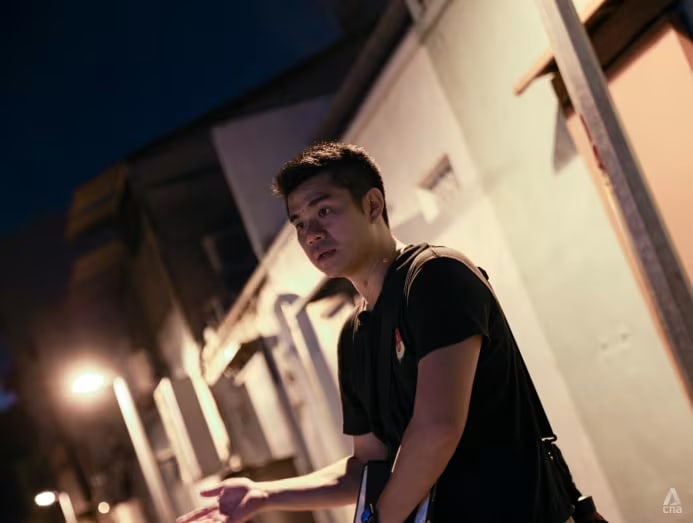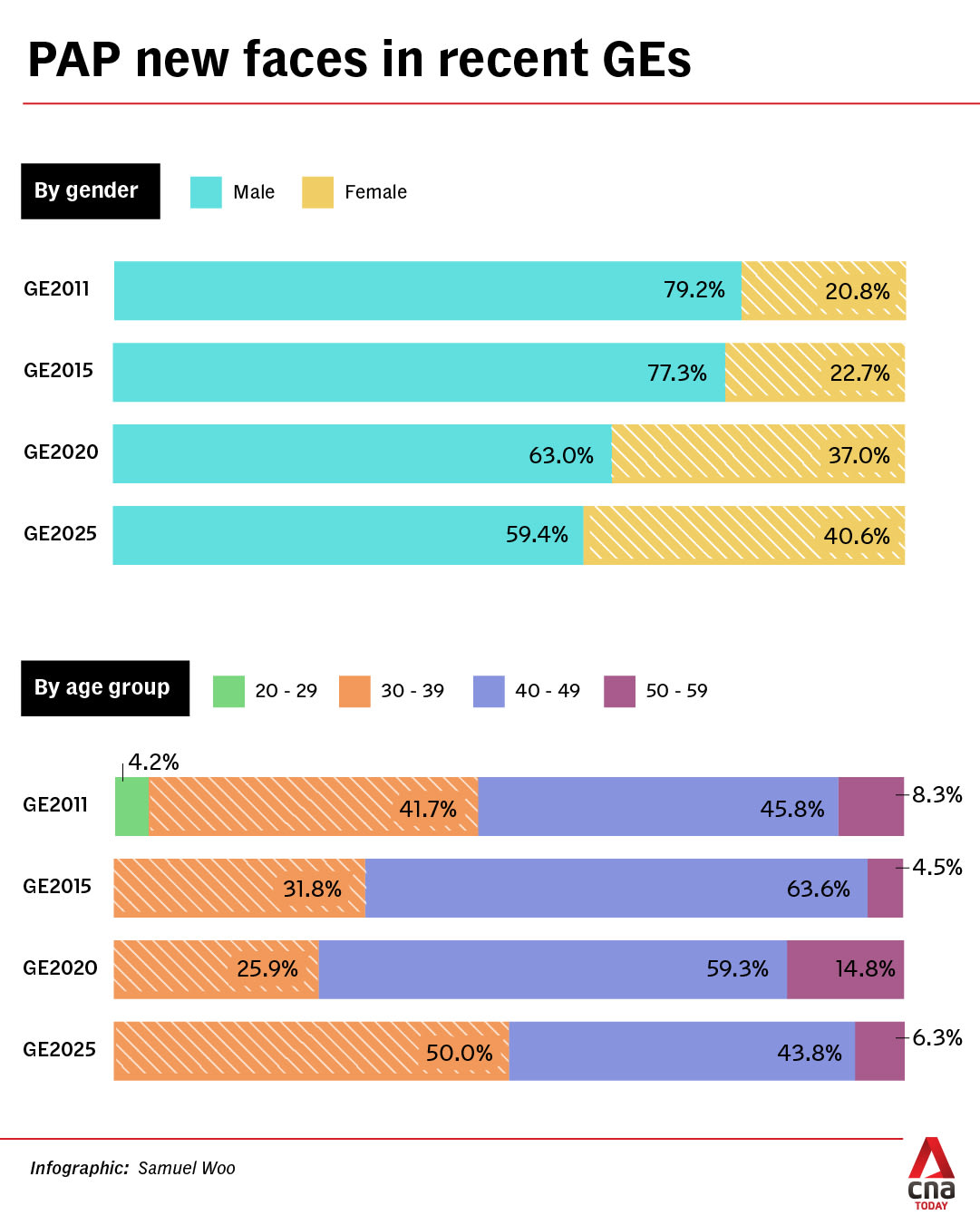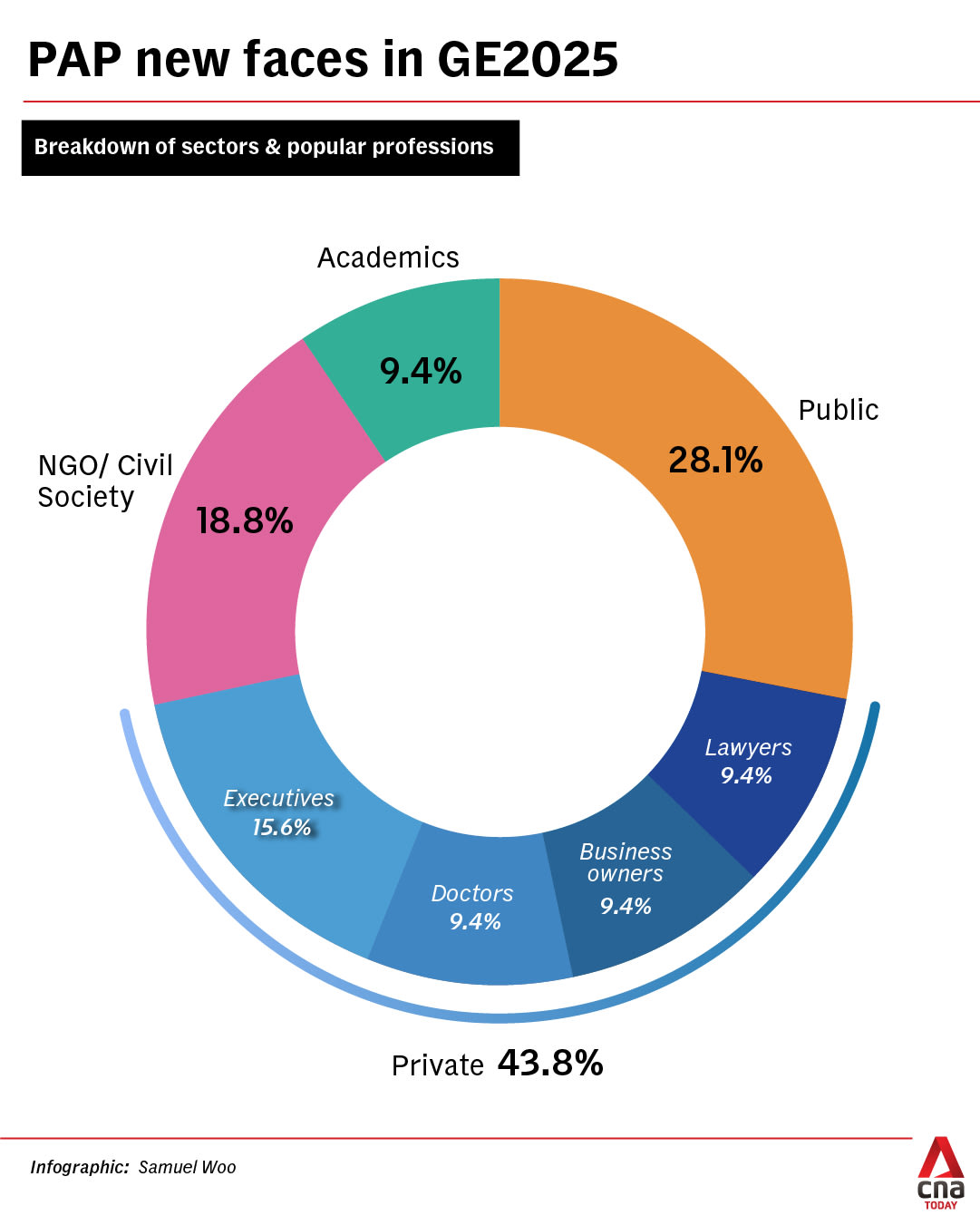GE2025: Deciphering the broader shifts behind PAP's record slate of new faces
Although there is a longstanding perception that the People’s Action Party draws heavily from the public sector including the military, data from recent general elections compiled and analysed by CNA TODAY indicate that the private sector has been the party’s main hunting ground. Other trends have emerged as well.


This audio is generated by an AI tool.
ver the past few months, new faces wearing the signature white shirts of the People’s Action Party (PAP) have been seen in neighbourhoods across Singapore, knocking on doors, talking to hawkers and shaking hands with people having their breakfast, sometimes doing so alongside senior Members of Parliament.
These men and women are expected to be among the PAP candidates to be fielded in the General Election (GE) on May 3 and as Prime Minister Lawrence Wong said, will feature the party’s “largest slate of new faces in recent history”.
Speaking at the PAP election manifesto launch on Thursday (Apr 17), Mr Wong confirmed 32 new candidates that the party plans to field in the upcoming election.
PAP fielded 27 new faces in GE2020, 22 in GE2015 and 24 in GE2011.
On Apr 12, Mr Wong reiterated the need for ever more new recruits when he unveiled his team for Marsiling-Yew Tee Group Representation Constituency (GRC).
Mr Wong, who is leading the ruling party into elections as its secretary-general for the first time, said: “We have an excellent team of MPs today, but to serve Singaporeans better, I need to renew and refresh the PAP team, to bring in new blood, new ideas and new energy.”
He added that this has been one of his key priorities since taking office in May 2024.
Apart from injecting more new faces at each successive election, a deeper look at the recruits introduced over the past four elections reflects other broad shifts within the party.
Over the years, it has been fielding more women and more young candidates under 40.
It continues to draw a significant number of new faces from the private sector, especially lawyers and doctors, but this year, it has also attracted a notably higher number of business owners and executives to join its ranks.
Political analysts told CNA TODAY that these trends show how the party is evolving to stay relevant in a changing political landscape by recruiting more diverse candidates, as it recognises that its track record may no longer be enough to win over a more discerning electorate.
MORE WOMEN AMONG NEW FACES
At the PAP Women’s Wing conference in August last year, Mr Wong said that he hoped to field more women candidates in the upcoming polls. That intent is now reflected in the numbers.
For GE2025, 40.6 per cent of the 32 new potential candidates are women, up from 37 per cent in 2020 and just over 20 per cent in 2011 and 2015.
Among the women introduced this year is Ms Cassandra Lee, an assistant director at management consultancy EY, who is part of PAP’s slate in West Coast–Jurong West GRC, led by Minister for National Development Desmond Lee.
At 33, she is the youngest new face announced so far.

Apart from the need to infuse the party with new blood, the push to bring in younger candidates is also tied to the long runway needed for these political recruits to learn the ropes in government, Mr Wong has said.
Speaking at the PAP conference in November last year, he said new candidates need time to learn and grow into leadership roles, as he himself did when he entered politics in 2011 at the age of 38.
Given that it is very difficult to “parachute” a new candidate directly into a ministerial role, Mr Wong said it was urgent for him to have a fresh crop of younger candidates who can provide vigour and continuity, and can eventually form the next leadership team for Singapore.
He reiterated this message on Apr 12 at the Marsiling-Yew Tee GRC event, stressing the importance of ensuring a “good pace of renewal” within the party in the coming years.
He pointed out that at 52, he is one of the youngest ministers in the Singapore Cabinet and a “minority” in this sense, as a sizable proportion of ministers are aged 60 and above.
Keeping the current team in government would mean that the average age of ministers would only increase and the process of renewal would be delayed, which “will not be in the interest in the longer term for Singapore”, he added.
However, attracting younger candidates to the party has long been an uphill task.
Dr Mustafa said some young people may be reluctant about joining politics because they might not feel ready or feel like they need more time to be "tested" on the ground first.
Others may be reluctant to step into the public spotlight at all, with political service not ranking highly on their list of priorities. At this stage in life, most people are focused on building their careers, he added.
Some younger people may also lean towards joining opposition parties instead if their interests, values and ideologies are more aligned with the opposition.
That being said, Dr Mustafa noted that PAP has done reasonably well in recruiting young candidates, especially this year.
Even though having young candidates does not necessarily mean winning more votes, it certainly does help with engaging voters of specific age groups, he said.
“The belief is that (candidates of each generation) would be able to understand better the challenges and concerns faced by their peers,” he added.

MORE BUSINESS OWNERS, EXECUTIVES
Traditionally, the PAP has drawn its new candidates from four main sectors:
- The public sector, which includes government ministries, statutory boards and the military
- Private sector companies, including government-linked corporations such as Temasek
- Non-governmental organisations and civil society groups such as charities and unions, including the National Trades Union Congress
- Academia
There is a longstanding perception that PAP draws heavily from the public sector including the military, but data from recent general elections compiled and analysed by CNA TODAY indicate that the private sector has been the party’s main hunting ground.
This year, nearly half (43.8 per cent) of the party’s 32 new faces come from the private sector. In comparison, 28.1 per cent were from the public sector; 18.8 per cent from non-governmental organisations or civil society; and 9.4 per cent from academia.
Although this marks a dip from GE2020, when 55.6 per cent of the party’s new candidates came from the private sector, the figure remains higher than in GE2011, when only 37.5 per cent had last held private-sector roles before being fielded for the polls.
Within PAP’s group of private sector candidates, the range of industries from which these new faces are recruited has also grown wider over the years.
Past line-ups often featured professionals from fields such as medicine and law, while this upcoming election has seen a marked uptick in business owners and executives entering the fray.
A quarter of this year’s new faces from the private sector hold roles as business owners and corporate leaders.
These include Mrs Bernadette Giam, 38, a director of food-and-beverage business Creative Eateries, and Mr Daniel Liu, 40, the managing director of urban planning consultancy Morrow Architects and Planners who is also executive director of Morrow Intelligence, an urban planning data analytics firm.

Pointing also to the entrance of neuroscientist and academic Choo Pei Ling, who will contest Chua Chu Kang GRC, Dr Mustafa said that the party’s decision to diversify its list of potential candidates is strategic, given that voters are also becoming more diverse in terms of their careers and passions.
Even then, political watchers pointed out that many of these PAP new faces, despite coming from more varied industries, are still people who would be considered successful in a “conventional” sense.
Associate Professor Chong Ja Ian, a political science lecturer from the National University of Singapore (NUS), said: “I think PAP is trying to recruit candidates it thinks are representative of leaders in the private sector today.”
Yet, they are mostly still “professionals with conventional pathways to success”, meaning they have excelled academically and built careers in sectors that are held in relatively high social regard in Singapore.





